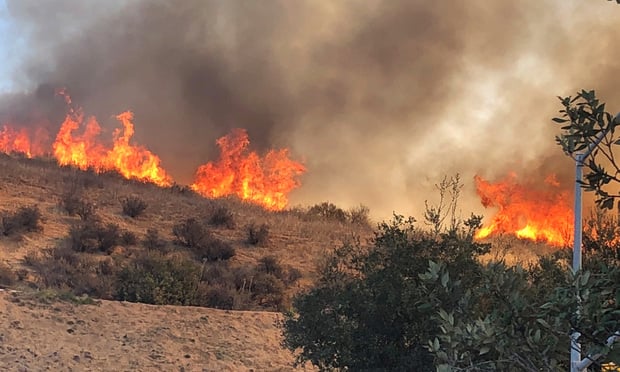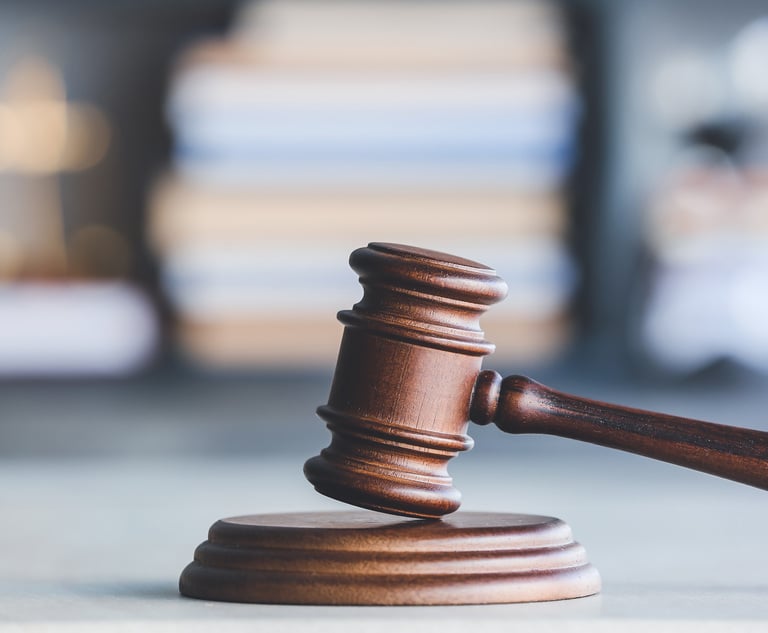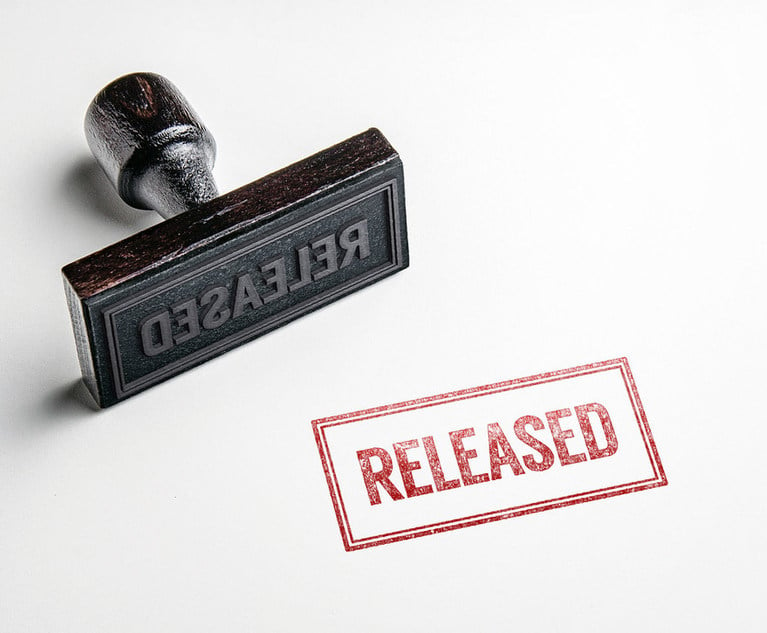Running on Empty: Why Pacific Gas and Electric Filed for Bankruptcy
The company is vulnerable to significant damage claims arising out of both the 2017 and 2018 California wildfires.
February 08, 2019 at 02:00 PM
8 minute read
 Wildfire in California.
Wildfire in California.
On Jan. 29, Pacific Gas and Electric Co. (PG&E) filed for bankruptcy protection in California pursuant to Chapter 11 of the United States Bankruptcy Code. PG&E is the nation's largest utility. It employs 24,000 people (15,000 of whom are subject to collective bargaining agreements) at a payroll expense of $4.8 billion annually and serves 16 million customers. It has $24 billion of outstanding funded debt. Despite the size of these numbers, the evidence available as of the date of this article reflects that PG&E was operating on a financially sound basis. As of Sept. 30, 2018, PG&E reported $71.4 billion in assets and $51.7 billion in liabilities on a book value basis. So what happened? What led to the bankruptcy?
In early November 2018, a wildfire known as the “Camp Fire” broke out, which ultimately incinerated over 150,000 acres, destroyed nearly 19,000 buildings, and took 86 lives in its wake. Property damage claims resulting from the California wildfires are now estimated to be $30 billion. California law (specifically California's State Constitution, as interpreted by its courts) imposes a form of strict liability for property damage where a public entity's equipment is involved in starting a fire: for example, an electric line sparking into a tree branch. PG&E's filing stems, in large part, from the billions of dollars of claims that PG&E might be responsible for, pursuant to what is known as California's “inverse condemnation” doctrine. See Declaration of Jason P. Wells, Senior Vice President and Chief Financial Officer of PG&E, Case No. 19-30088 (N.D. Cal.) (the “Wells Declaration”), at 3-4, 14-16.
The Wells Declaration states that the Chapter 11 filings were “necessitated by a confluence of factors resulting from the catastrophic and tragic wildfires that occurred in Northern California in 2017 and 2018, and PG&E's potential liabilities arising therefrom.” Wells specified that “[t]he multitude of pending claims and lawsuits, and the thousands of additional claims that will be asserted, made it abundantly clear that PG&E could not continue to address those claims and potential liabilities in the California state court system, continue to deliver safe and reliable service to its 16 million customers, and remain economically viable.” Wells Declaration, at p.3. Wells asserted that the Chapter 11 filings were “the only viable option” to resolve those issues and to assure PG&E's long-term viability. Id. at 19.
In California, to prevail on a cause of action for inverse condemnation, a private property owner need only show that a public entity has taken or damaged her property in connection with a public use. Barham v. S. Cal. Edison Co., 74 Cal. App. 4th 744, 751 (1999). It appears that whether the entity was negligent is not relevant to establish liability. See Pacific Bell Tel. Co. v. S. Cal. Edison Co., 208 Cal. App. 4th 1400, 1408-11 (2011). Courts have interpreted the California Constitution to mean that a public entity is liable for any “injury to real property proximately caused by a public improvement … whether foreseeable or not.” Id.; see also Cal. Const. art. I, §19. Relevant to PG&E, California courts have established that inverse condemnation applies equally to privately-owned utilities such as PG&E. See Barham, 74 Cal. App. 4th at 744; Pacific Bell, 208 Cal. App. 4th at 1400. As a result, if a court finds that the injuries suffered by the fire survivors were caused by PG&E's equipment, PG&E will likely be liable for damages whether or not the injuries were foreseeable. See Barham, 74 Cal. App. 4th at 751.
During a recent proceeding arising out of forest fire survivors' claims from 2017, PG&E took the position that inverse condemnation should not apply to a private utility because it cannot raise its rates without permission from California Public Utilities Commission (the “Commission”). Judicial Council Coordination Proceeding No. 4955, Order Overruling PG&E's Demurrers (May 21, 2018), at p.1. In fact, the Commission has previously stated that it might not allow PG&E to raise its rates, even if PG&E is found liable for the forest fires. See Commission Decision No. 17-11-033, at 65 (Dec. 6, 2017). The policy behind inverse condemnation is that individual property owners should not have to bear the burden of risks from public improvements alone since those public improvements benefit the entire community. Pacific Bell, 208 Cal App. 4th at 1407. Thus, PG&E reasoned that, unless it was obvious that PG&E would be able to pass on any damage awards to the community by increasing rates, the inverse condemnation claims should be dismissed. Order Overruling PG&E's Demurrers, at p.1.
The court disagreed and allowed the inverse condemnation claims to proceed, leaving PG&E vulnerable to significant damage claims arising out of both the 2017 and 2018 wildfires. See id. at p.6. By filing for bankruptcy protection, PG&E intends to have those claims litigated in a single forum, and by bringing together all creditors and stakeholders before the bankruptcy court, including lenders owed $24 billion, employees, and others, to hopefully limit the impact of the claims, particularly if it cannot spread costs related to such claims to its ratepayers. Meanwhile, it also intends to simultaneously seek regulatory and/or legislative relief.
The Wells Declaration specifies that “the Chapter 11 Cases are not a strategy or attempt to avoid PG&E's responsibility” for the harm to the communities that resulted from the 2017 and 2018 wildfires. Wells Declaration, at 4. Rather, PG&E seeks to establish a process to resolve its liabilities “more quickly and equitably than those liabilities could be addressed and resolved in the state court system,” restore PG&E's financial stability to allow PG&E to invest in wildfire prevention initiatives, work with California policymakers to address reforms due to a significant increase in wildfire risk, and enable PG&E to continue its restoration and rebuilding efforts in communities affected by the wildfires. Id. at 4-5.
Despite the reassurances in the Wells Declaration, the bankruptcy process itself is likely to cause, at the very least, delays in the resolution of fire survivors' claims. When an entity files for bankruptcy, there is an automatic stay that applies to any action pending against the debtor or any action that could have been brought against the debtor prior to the bankruptcy filing. See 11 U.S.C. § 362. The result is that fire survivors could be waiting a very long time to have their cases heard, resolved, and ultimately satisfied (in part or in whole) through a payment via PG&E's bankruptcy. Further, fire survivors may not recover the full amounts of their claims because before any general unsecured creditor can receive a distribution, administrative expenses of the Chapter 11 case and other priority claims, such as employee wage claims, must be satisfied. Only after these claims are satisfied can any monies be distributed to general unsecured creditors such as the fire survivors. It is possible that there will be limited funds available to pay fire survivors' claims, particularly if the general unsecured class includes other significant claims.
This is not PG&E's first rodeo in the bankruptcy arena. In 2001, PG&E's first bankruptcy resulted in a settlement that would ultimately cost its ratepayers approximately $7 billion. See Approved Settlement Agreement, Securities & Exchange Commission Archives, https://www.sec.gov/Archives/edgar/data/75488/000100498003000296/finalexhibit99.htm. The 2001 bankruptcy had a different cause—specifically, pricing changes for required purchases of renewable energy that PG&E was not previously able to pass on to its ratepayers. The current bankruptcy, although resulting from a different driver, will likely end up in the place: increased rates assessed against ratepayers in order to recover losses stemming from fire victims' claims. Indeed, something's got to give. Either the wildfire damage claims must be reduced, the cost of electric service for ratepayers increased, or funded debt claims must receive less than par. It would seem most likely that it is the ratepayers who will fund the bankruptcy plan. Indeed, PG&E has already asked state regulators to approve a plan to increase its rates such that, in 2020, an average residential customer would pay an additional $10.57 a month for gas and electricity. See Katherine Blunt, Rebecca Smith, “California Girds for Higher Power Prices From PG&E After Fires,” The Wall Street Journal (Dec. 13, 2018).
Rachel H. Ginzburg is an associate, Warren J. Martin Jr. is a principal, and Rachel A. Parisi is counsel in the Bankruptcy and Financial Restructuring Group of Porzio Bromberg & Newman in Morristown.
This content has been archived. It is available through our partners, LexisNexis® and Bloomberg Law.
To view this content, please continue to their sites.
Not a Lexis Subscriber?
Subscribe Now
Not a Bloomberg Law Subscriber?
Subscribe Now
NOT FOR REPRINT
© 2025 ALM Global, LLC, All Rights Reserved. Request academic re-use from www.copyright.com. All other uses, submit a request to [email protected]. For more information visit Asset & Logo Licensing.
You Might Like
View All



Retiring AOC Director Judge Glenn A. Grant Walks Away From Judiciary 'Tremendously Impressed' by New Jersey's Judges
5 minute readTrending Stories
- 1Uber Files RICO Suit Against Plaintiff-Side Firms Alleging Fraudulent Injury Claims
- 2The Law Firm Disrupted: Scrutinizing the Elephant More Than the Mouse
- 3Inherent Diminished Value Damages Unavailable to 3rd-Party Claimants, Court Says
- 4Pa. Defense Firm Sued by Client Over Ex-Eagles Player's $43.5M Med Mal Win
- 5Losses Mount at Morris Manning, but Departing Ex-Chair Stays Bullish About His Old Firm's Future
Who Got The Work
J. Brugh Lower of Gibbons has entered an appearance for industrial equipment supplier Devco Corporation in a pending trademark infringement lawsuit. The suit, accusing the defendant of selling knock-off Graco products, was filed Dec. 18 in New Jersey District Court by Rivkin Radler on behalf of Graco Inc. and Graco Minnesota. The case, assigned to U.S. District Judge Zahid N. Quraishi, is 3:24-cv-11294, Graco Inc. et al v. Devco Corporation.
Who Got The Work
Rebecca Maller-Stein and Kent A. Yalowitz of Arnold & Porter Kaye Scholer have entered their appearances for Hanaco Venture Capital and its executives, Lior Prosor and David Frankel, in a pending securities lawsuit. The action, filed on Dec. 24 in New York Southern District Court by Zell, Aron & Co. on behalf of Goldeneye Advisors, accuses the defendants of negligently and fraudulently managing the plaintiff's $1 million investment. The case, assigned to U.S. District Judge Vernon S. Broderick, is 1:24-cv-09918, Goldeneye Advisors, LLC v. Hanaco Venture Capital, Ltd. et al.
Who Got The Work
Attorneys from A&O Shearman has stepped in as defense counsel for Toronto-Dominion Bank and other defendants in a pending securities class action. The suit, filed Dec. 11 in New York Southern District Court by Bleichmar Fonti & Auld, accuses the defendants of concealing the bank's 'pervasive' deficiencies in regards to its compliance with the Bank Secrecy Act and the quality of its anti-money laundering controls. The case, assigned to U.S. District Judge Arun Subramanian, is 1:24-cv-09445, Gonzalez v. The Toronto-Dominion Bank et al.
Who Got The Work
Crown Castle International, a Pennsylvania company providing shared communications infrastructure, has turned to Luke D. Wolf of Gordon Rees Scully Mansukhani to fend off a pending breach-of-contract lawsuit. The court action, filed Nov. 25 in Michigan Eastern District Court by Hooper Hathaway PC on behalf of The Town Residences LLC, accuses Crown Castle of failing to transfer approximately $30,000 in utility payments from T-Mobile in breach of a roof-top lease and assignment agreement. The case, assigned to U.S. District Judge Susan K. Declercq, is 2:24-cv-13131, The Town Residences LLC v. T-Mobile US, Inc. et al.
Who Got The Work
Wilfred P. Coronato and Daniel M. Schwartz of McCarter & English have stepped in as defense counsel to Electrolux Home Products Inc. in a pending product liability lawsuit. The court action, filed Nov. 26 in New York Eastern District Court by Poulos Lopiccolo PC and Nagel Rice LLP on behalf of David Stern, alleges that the defendant's refrigerators’ drawers and shelving repeatedly break and fall apart within months after purchase. The case, assigned to U.S. District Judge Joan M. Azrack, is 2:24-cv-08204, Stern v. Electrolux Home Products, Inc.
Featured Firms
Law Offices of Gary Martin Hays & Associates, P.C.
(470) 294-1674
Law Offices of Mark E. Salomone
(857) 444-6468
Smith & Hassler
(713) 739-1250






